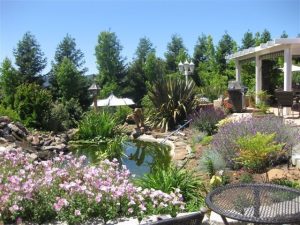Spring and fall are actually the best times to do most garden planting in the Mother Lode, but even in triple-digit weather, we still spend long weekends working on the garden of our dreams. It’s a hard habit to break, this insistence on planting throughout our inhospitably hot, dry foothill summers – which made me think recently about other gardening habits and myths that the latest science shows aren’t true.
Myth #1: Our foothills soil is bad for gardening because of the clay.
Having used many choice curse words, and thrown a few shovels across the yard after hours of trying to dig planting holes up here (I am a Bay Area transplant), I agree that ours is not an easy soil to work. But the good news is clay happens to be a nutrient magnet for plants.
Clay’s surface structure and chemical properties naturally attract many of the essential elements of plant nutrition, such as calcium, magnesium, potassium, hydrogen and iron, among others. “Because clay minerals are so active in nutrient exchanges,” explains the California Master Gardener Handbook, “they largely determine how well plants will grow in that soil.”
Myth #2: The best way to plant is to fill the newly dug hole with soil amendments.
Recent studies show that nothing is gained by amending backfill with organic matter, fertilizer or other substances. And some amendment practices can actually be harmful, like chucking a handful of fertilizer in the planting hole too close to the plant’s roots, which can chemically burn them. Current research tells us that the best planting practice is to use the soil you just shoveled out as backfill and to use organic matter as a mulch or compost spread over the soil after planting to improve soil structure, conserve water and discourage weeds.
Myth #3: Use vitamin B1 when you plant in order to avoid transplant shock.
More recent studies have shown that vitamin B1 alone does nothing to speed rooting or prevent transplant shock. Here’s what does work: make sure you have picked a spot that suits the particular plant’s preferred growing conditions in terms of sun exposure and drainage; minimize stress by planting on relatively cooler days and time of day, and don’t let the plant dry out.
Myth #4: You should fertilize landscape trees and bushes every year.
While trees and shrubs less than two years old often benefit from fertilizing, research has shown that, with few exceptions, mature trees and shrubs in California do not need fertilizer if the leaves look healthy and there is new shoot growth each year. If fertilizer is needed, only nitrogen is necessary because California soils are most commonly deficient only in nitrogen.
Speaking of spring – and again, fall – research really does show that most new plants (and seeds) get a better start in life when we use those cooler, wetter seasons for planting. It gives plant roots more time to become established before having to deal with our more stressful summers and winters. So there you go: recent science has given us a planting habit worth starting!
Rachel Oppedahl is a Tuolumne County Master Gardener who is using her UC Cooperative Extension training to change her BAT (Bay Area Transplant) gardening habits.


